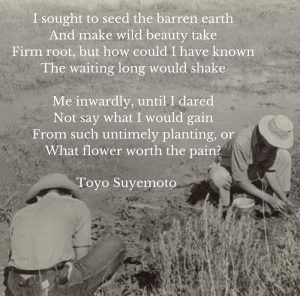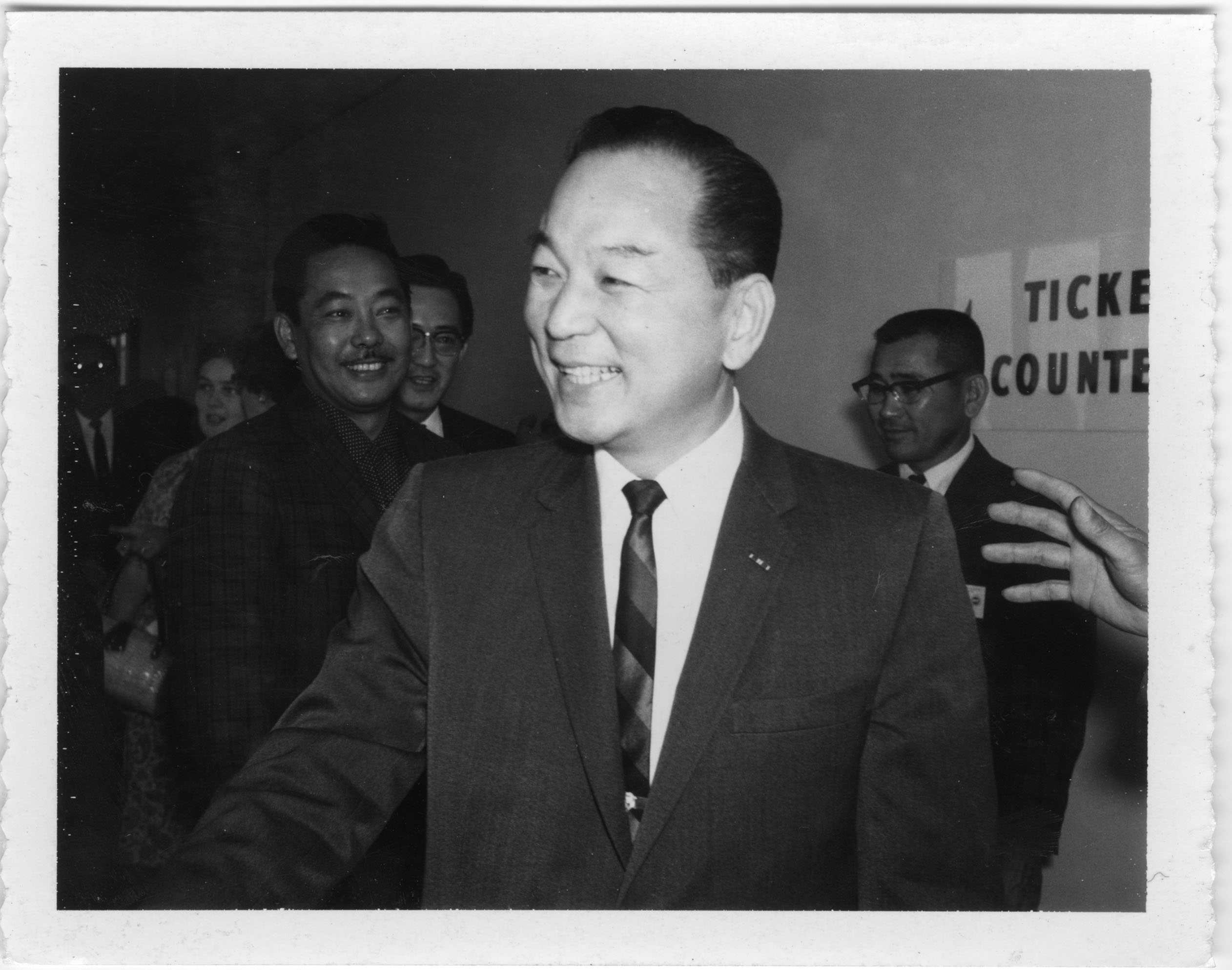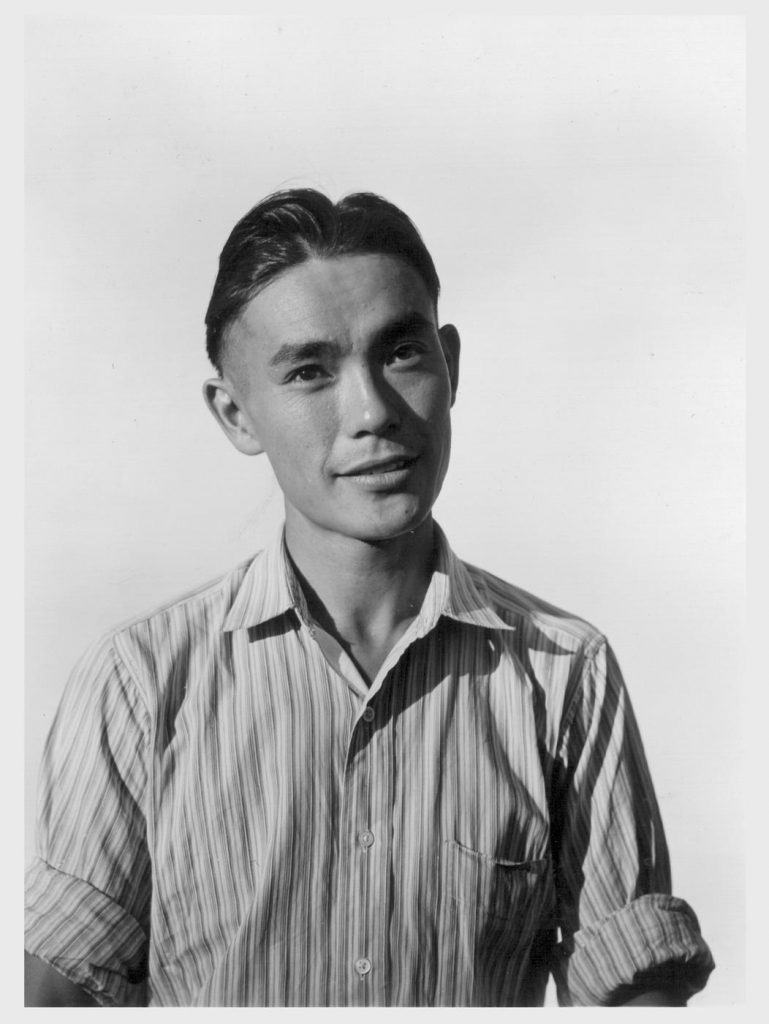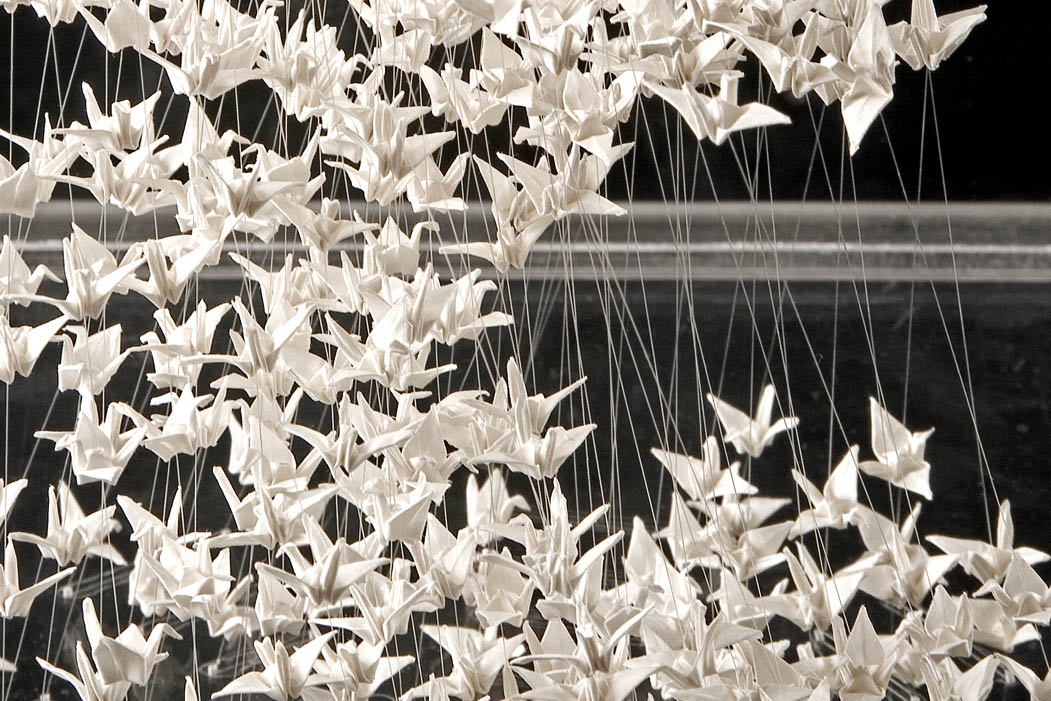September 15, 2016
I had intended to contribute to this blog a lot more, and one of the types of pieces I hoped to do were essays on prominent figures in Japanese American history on the 100th anniversary of their births. By 1916, we see the start of the peak period of Nisei births, so there are many to choose from. But alas, my ambition out-stripped my ability to do these, and most of the anniversaries have come and gone. But since Densho is about to celebrate its 20th anniversary, I thought I’d dust off this idea and quickly note those who would have turned 100 this year.
It is an interesting group (though like a school principal talking about graduating classes, I’ll probably end up saying this every year) and one that seems to fall naturally into pairs.
Artists and Writers
 For starters, there are representatives from Nisei literary and artistic circles. Poet Toyo Suyemoto (born January 14) grew up in Sacramento and was part of the Northern California Nisei literary scene in the late 1930s and worked on the Topaz literary journals while in camp. Overcoming personal tragedies, she became a librarian in the Midwest after the war, and in her poetry, became one of the most eloquent chroniclers of the wartime incarceration experience. Artist Ken Nishi (born June 7) was another Californian who attained prominence in the late 1930s, but who settled away from the coast after the war, in New York, where he worked as an artist in various media and as an art educator and administrator. His wife was the noted sociologist and activist Setsuko Matsunaga Nishi.
For starters, there are representatives from Nisei literary and artistic circles. Poet Toyo Suyemoto (born January 14) grew up in Sacramento and was part of the Northern California Nisei literary scene in the late 1930s and worked on the Topaz literary journals while in camp. Overcoming personal tragedies, she became a librarian in the Midwest after the war, and in her poetry, became one of the most eloquent chroniclers of the wartime incarceration experience. Artist Ken Nishi (born June 7) was another Californian who attained prominence in the late 1930s, but who settled away from the coast after the war, in New York, where he worked as an artist in various media and as an art educator and administrator. His wife was the noted sociologist and activist Setsuko Matsunaga Nishi.
Probably the two most famous people in this group to mainstream Americans are Iva Toguri d’Aquino (born on July 4) and Masayuki “Spark” Matsunaga (born on October 9). For many, Toguri’s name is synonymous with that of “Tokyo Rose,” the mythical radio voice that spewed English language Japanese propaganda aimed at American servicemen during World War II. In reality, Toguri was a Nisei from Southern California who was one of thousands of Nisei trapped in Japan during World War II, and who had to do what she needed to in order to survive under very difficult conditions. A combination of venal journalists and Cold War politics led to an eventual trial and conviction of treason. Years later, as a result of an effort that served as an important precursor to the redress movement, she was granted a pardon by President Gerald Ford in 1977. One of those who supported the drive to pardon her was Matsunaga, then a congressman from Hawai’i and later one Hawai’i’s U.S. senators. A veteran of the 100th Infantry Battalion and key figure in the redress movement, he remains a beloved figure in Hawai’i.

Intellectuals and Documentarians
Though all went on to prominent lives and careers, the next group of four are all remembered among those who study Japanese American history for the first hand observations of the wartime incarceration and aftermath that they made as young men as part of wartime research projects. Three did so as fieldworkers for the Japanese American Relocation and Evacuation Study (JERS), a controversial research project housed at the University of California at Berkeley and led by sociologist Dorothy Swaine Thomas.

Togo Tanaka (born January 7) was the prewar English section editor of the Rafu Shimpo newspaper, a member of the Japanese American Citizens League, and one of the most eloquent writers and thinkers about the Nisei experience at that time. He worked as a “documentary historian” at Manzanar, and that job made him the target of angry mobs during the riot/uprising of December 1942. After being among those removed from the camp for his own safety, he further documented Manzanar and the prewar Japanese American community for JERS. Tanaka later became a publisher and successful businessman in Chicago and Los Angeles.
Charles Kikuchi (born January 18) grew up in an orphanage in Northern California and is one of the most voluminous chroniclers of Japanese American life, having kept a diary for 47 years that spanned some 100,000 pages. Part of a Nisei intellectual circle at Berkeley before the war, he was the anonymous author of “A Young American with a Japanese Face,” a revealing personal essay that appeared in From Many Lands, an essay collection compiled by Louis Adamic in 1940. Not surprisingly, he agreed to work for JERS as well. His diaries of concentration camp life, which run many hundreds of pages, are some of the most detailed in existence. An edited subset of his diaries that mostly cover his time in the Tanforan Assembly Center was published in 1973 as The Kikuchi Diary: Chronicle from an American Concentration Camp, edited by John Modell. Later, his fieldwork for JERS included interviews with sixty four Japanese Americans who resettled in Chicago, interviews that are remarkably revealing and that will dispel any illusions about Japanese Americans being any kind of “model minority.” Kikuchi later became a social worker and activist in Chicago and New York.
James Sakoda (born April 21) was another Berkeley Nisei intellectual and JERS fieldworker, who collected data at the Tulare Assembly Center, Tule Lake, and Minidoka. His work at the latter was focused on the group that refused to leave the concentration camp in 1945 and later became the topic of his doctoral dissertation. He went on to a multifaceted career as an academic psychologist at the University of Connecticut and Brown University, a pioneering figure in computer programming, and an expert in origami.
Tom Sasaki (born April 3) grew up in Imperial County, California and graduated with a psychology degree from Berkeley in 1939. Incarcerated at Poston, he worked as a staff member for the Bureau of Sociological Research at Poston, another camp based research project. After stints as a teacher on the Navajo Reservation in New Mexico and with the U.S. Strategic Bombing Survey in Tokyo, he returned to the U.S., where he became a fieldworker for an Interior Department-funded study of Japanese American resettlement after the war. Assigned to Los Angeles, he spent the second half of 1946 embedded there and produced some 500 pages of reports detailing the struggles of the returnees and the community politics of the period. Sasaki went on to an academic career, holding faculty positions at the University of New Mexico, Johns Hopkins, and Notre Dame, though he did no further work on Japanese Americans.
[The raw notes, diaries, and reports of Tanaka, Kikuchi, Sakoda, and Sasaki are all now available online as part of the Japanese American Evacuation and Resettlement digital archive at UC Berkeley.]
Allies
Not all who were important to Japanese American history were themselves Japanese American. Ralph Smeltzer (born May 26) and Mary Blocher Smeltzer (born October 17, 1915; okay, so I’m cheating a bit here) were Church of the Brethren members who were among those who assisted Japanese Americans during the war. Both were school teachers in Southern California before the war who became teachers at Manzanar during the war and later managed hostels for Japanese American resettlers in Chicago and New York. Both went on to long careers as peace and human rights activists after the war.
Resisters
But perhaps the most interesting pairing is of two who resisted, but who nonetheless ended up on opposite sides. Frank Emi (born September 23) and Minoru Yasui (born October 19) are both well known for their resistance today, Emi as one of the leaders of the draft resistance movement at Heart Mountain and Yasui as one of the legal challengers of the curfew aimed at Japanese Americans. But Yasui later came to oppose the resistance efforts of Emi and his compatriots. Both remained engaged with the Japanese American community throughout their lives and were active in the redress movement, Emi through the National Coalition of Redress/Reparations and Yasui through the JACL. Both also were much honored in their later lives, as our community has come to recognize and honor resistance to a much greater degree than in years past. A documentary film on Yasui is being produced as part of a series of projects commemorating his 100th birthday.
—
Two thoughts on this group: (1) As someone who has been involved in the Japanese American community for some thirty years, I’ve been hearing variations of the idea that “the Nisei are dying out” pretty much the entire time. But the realization that the core population of Nisei are approaching 100th birthdays makes it clear that this is really true now. Outside of a few outliers, it is just the younger Nisei who are still with us. An era is truly coming to an end. (2) Those born 100 years ago were young adults at the time of World War II and that war couldn’t help but have had a major impact on their lives. Most of this select group were able to overcome the problems being Japanese American during World War II brought, and some even leveraged those problems into future careers. But for all of these notable stories, most of which are “success stories,” there are many others of lives destroyed or irretrievably altered. I hope we are able to remember some of those stories as well.
